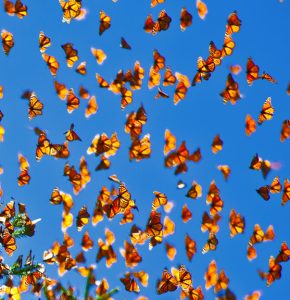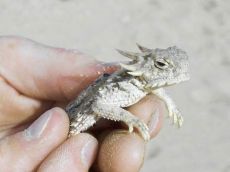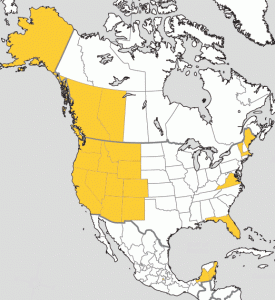We live in the age of high tech. High technology. So common, so ubiquitous, that we almost take it for granted. This morning most of us got up and grabbed hold of a small device that has more computing power than that which landed a man on the moon. We’re hardly alone. Did you know, that over four-and-a-half billion people – more than half the humans living on the planet – own and use a cell phone?
 Bees and butterflies are disappearing at an alarming rate. But who really cares and why should they? Let’s see. Pollinators are the little things that let plants reproduce. Plants in turn support the vast majority of life on this planet – including ours. So that’s the only reason you should need to care.
Bees and butterflies are disappearing at an alarming rate. But who really cares and why should they? Let’s see. Pollinators are the little things that let plants reproduce. Plants in turn support the vast majority of life on this planet – including ours. So that’s the only reason you should need to care.
Growing fish and vegetables together with aquaponics is a great way to produce low cost organic food for you and your family. The amount of production can be high for the small amount of maintenance you put into it. But in order to get good results, you need to choose the right fish for your aquaponics system.
“If it’s birds versus jobs, you’re dead. You lose. If it’s corporate greed versus protecting the forests, that’s good.”
Jon Haber of Fleishman-Hillard, strategic communications firm
Unfortunately, the general public knows very little about the conflict between wildlife and transportation. A 2006 study by the University of Denver found four major barriers to effective citizen participation in wildlife sensitive transportation projects:
Unless you’re independently wealthy, you may need to raise money to run your campaign. Fundraising is nothing new to conservationists; it can mean everything from “tin cupping” to receiving major, multi-year grants. But don’t be overwhelmed. Reduced to its simplest expression, fundraising is the act of asking a person for a gift of money.
Research prospective donors Ask yourself, “Who would give us money to work on this issue?” List all the people, organizations, businesses, foundations and agencies that are touched by the wildlife and transportation conflict. Get creative.
Now just ask Send an introductory letter and follow up with a friendly phone call. Offer to meet over coffee to tell them more about your activities.
Use the internet to raise funds and build relationships with donors. Develop a website to tell the world about your campaign and add a mechanism for accepting donations.
Host fundraising events at or near your area of interest. Bring people to see the area, the species and the project site for themselves.
Government Grants
Federal, state and local governments award hundreds of millions of dollars every year to nonprofit organizations. Winning a grant is a competitive process, and the best grant writers are the ones who know how to read a request for proposals (RFP), address the funder’s goals, and provide the right documentation to support their plans.
The United States government provides “direct” and “pass through” grants. Direct grants, as the name implies, go directly from the government to your organization. Competition for direct grants is fierce. The federal government also gives monies to individual states for distribution as pass through grants. To be considered for a pass through grant, you must go to the appropriate state agency. Since only in-state applicants are considered, competition is less intense. Government grants are either “competitive,” meaning applicants must compete for a share of the money or they are “formula,” meaning grants are allocated on the basis of a specific formula.
CAUTION: BE CAREFUL WHAT YOU ASK FOR
Government agencies may support your efforts to the extent that they are aligned with the agency’s priorities. They may not be so keen to give you money to support your efforts to oppose them. Once you accept money from a government agency, the dynamic of your relationship may change dramatically from advocate to employee.
Where do I find information on government grants?
The best source is the Catalog of Federal Domestic Assistance. Grants are divided into 20 main categories and almost 200 subcategories. Each entry includes the following information:
- Name of the federal agency distributing the grant
- Federal legislation that authorized the funds for the grant program
- Program’s goals and objectives
- Financial assistance the program offers
- Non financial assistance
- Restrictions and eligibility requirements
- Application and selection processes
- Examples of projects that have been funded in the past
- Other government programs with similar objectives
Grants.gov has information on 900 individual grant programs that provide more than $350 billion in grants each year. The Federal Register, published by the U.S. Government Printing Office has announcements about federal grant programs and opportunities.
Writing a grant proposal
So you want to write a proposal? Now that you have defined your objectives and researched your potential funders, you’re ready for the next step. A proposal is a short, narrative document that describes your organization and pitches your idea to the granting agency. Proposals come in three forms:
Letter of intent – Typically two to three pages long, the letter of intent (LOI) describes your program in a nutshell and explains how it fits the needs of the granting agency. Based on the LOI, the granting agency can decide whether to ask for a longer, more detailed proposal.
Short proposal or letter proposal – Similar to a letter of intent, the letter proposal describes the project, the need and requests funds.
Long proposal – Most often used by foundations and government granters, the long proposal includes a cover letter, a proposal summary, and as many as ten pages of proposal text, followed by appendices that provide greater detail about the project.
How to Write a Grant Proposal
Most grantors will provide their own application forms or basic guidelines, but in some cases you will need to start from scratch. While grants can come from a variety of sources such as foundations or government agencies, most require the same basic information in the grant proposal. Here are the most common sections of a grant proposal and the information you should include:
Your cover letter should include a two to three sentence summary of your proposal. Give a brief description of your organization, mission, and an overview of your accomplishments. Make your case for why the grantor should invest in your vision.
A problem or needs statement should demonstrate the importance, urgency and relevance of your proposal. Be clear and assume that the reader doesn’t already know everything about the issue. Convince the grantor that you are the right organization for the job.
The bulk of your proposal is found in the work plan, which includes your target audience and any planning or research you may have done to prepare. Describe the proposed activities, when and where they are to take place and project start and end dates. List the project lead and other involved staff along with their qualifications.
Tell your prospective grantor your anticipated outcomes and how the project will improve the situation.
Include information on other funding you can use for the proposed project. Grantors rarely want to be the sole source of support for a project. Be sure to mention any in-kind contributions such as supplies or work space.
Attach a budget showing the various project costs including staff salaries, direct expenses and administrative or overhead expenses.
Grantors are likely to request additional materials, such as proof of your tax-exempt status, a list of your board members, last year’s financial statement and budgets for the current fiscal year.
Additional Resources
EPA and Purdue University’s Grant Writing Tutorial
CONVIO: Best Practices Guides
Download these free guides and learn the secrets of nonprofit online fundraising, advocacy and email marketing that can help you find new constituents and turn them into long-term, loyal donors.
Web Visibility Services by WRITE LAW
GROUNDSPRING: Offers online fundraising solutions for nonprofits
Fundraising for the Long Haul
Klein, K. 2000. Jossey-Bass, San Francisco, California.
Big Gifts for Small Groups: A Board Member’s 1-Hour Guide to Securing Gifts of $500 to $5,000
Robinson, A. 2004. Emerson & Church, Medfield, MA
Think of fundraising as barter: donors give money in exchange for your organization giving good work and benefits to the community. Soliciting donations is simpler than you think!
 After a court-ordered analysis of the flat-tailed horned lizard’s status, the U.S. Fish and Wildlife Service (FWS) determined threats to the species “are not as significant as earlier believed” and that the species does not need protection under the Endangered Species Act.
After a court-ordered analysis of the flat-tailed horned lizard’s status, the U.S. Fish and Wildlife Service (FWS) determined threats to the species “are not as significant as earlier believed” and that the species does not need protection under the Endangered Species Act.
 In participation with national “Give Wildlife a Brake” week, public-private partners launched I-90 Wildlife Watch, a citizen-based wildlife monitoring project that invites motorists to report wildlife and roadkill sightings along I-90 in the Snoqualmie Pass region of Washington. Some species that can be observed in this area include deer, elk, black bears, cougars, bobcats, coyotes, and skunks.
In participation with national “Give Wildlife a Brake” week, public-private partners launched I-90 Wildlife Watch, a citizen-based wildlife monitoring project that invites motorists to report wildlife and roadkill sightings along I-90 in the Snoqualmie Pass region of Washington. Some species that can be observed in this area include deer, elk, black bears, cougars, bobcats, coyotes, and skunks.
 Check out this amazing and information March 2010 joint USGS & USFWS video on threats to desert tortoise habitat and the recovery efforts of USGS scientists:
Check out this amazing and information March 2010 joint USGS & USFWS video on threats to desert tortoise habitat and the recovery efforts of USGS scientists:
“The Heat Is On: Desert Tortoises and Survival”

